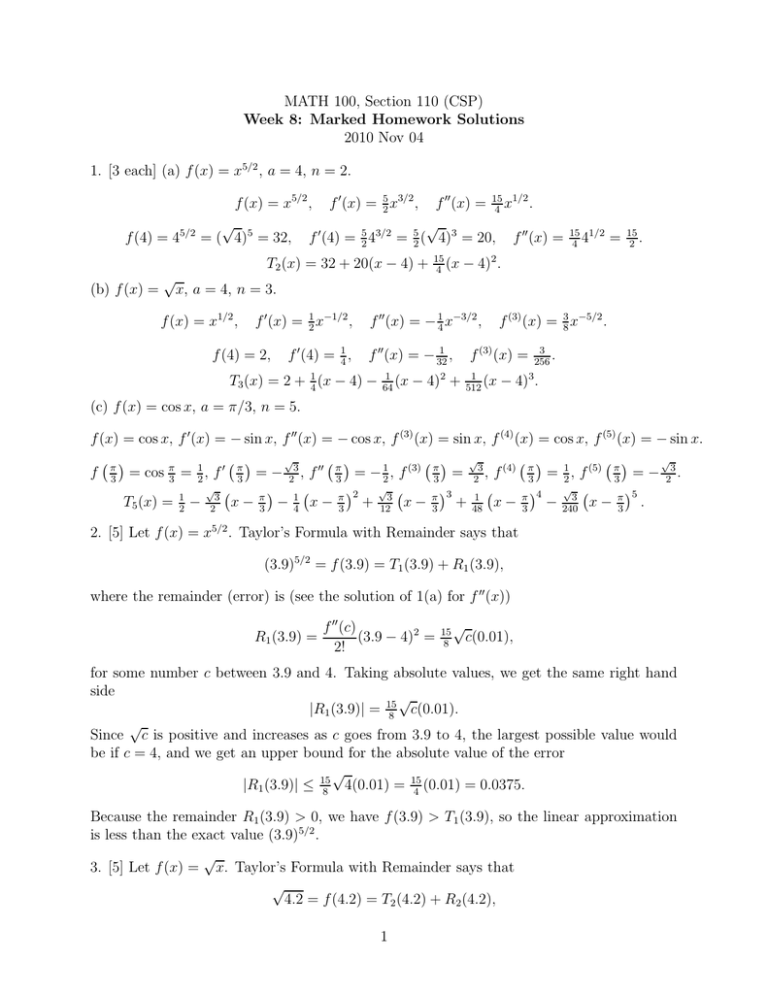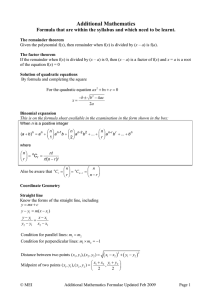MATH 100, Section 110 (CSP) Week 8: Marked Homework Solutions
advertisement

MATH 100, Section 110 (CSP) Week 8: Marked Homework Solutions 2010 Nov 04 1. [3 each] (a) f (x) = x5/2 , a = 4, n = 2. f (x) = x5/2 , √ f (4) = 45/2 = ( 4)5 = 32, (b) f (x) = √ f 0 (x) = 25 x3/2 , f 0 (4) = 25 43/2 f 00 (x) = 15 x1/2 . 4 √ = 52 ( 4)3 = 20, f 00 (x) = T2 (x) = 32 + 20(x − 4) + 15 (x 4 15 1/2 4 4 = 15 . 2 − 4)2 . x, a = 4, n = 3. f (x) = x1/2 , f 0 (x) = 21 x−1/2 , f (4) = 2, f 0 (4) = 14 , f 00 (x) = − 14 x−3/2 , f (3) (x) = 1 f 00 (x) = − 32 , T3 (x) = 2 + 14 (x − 4) − 1 (x 64 f (3) (x) = 83 x−5/2 . − 4)2 + 1 (x 512 3 . 256 − 4)3 . (c) f (x) = cos x, a = π/3, n = 5. f (x) = cos x, f 0 (x) = − sin x, f 00 (x) = − cos x, f (3) (x) = sin x, f (4) (x) = cos x, f (5) (x) = − sin x. √ √ √ f π3 = cos π3 = 12 , f 0 π3 = − 23 , f 00 π3 = − 21 , f (3) π3 = 23 , f (4) π3 = 21 , f (5) π3 = − 23 . √ 2 √ 3 4 √ 5 1 T5 (x) = 12 − 23 x − π3 − 14 x − π3 + 123 x − π3 + 48 x − π3 − 2403 x − π3 . 2. [5] Let f (x) = x5/2 . Taylor’s Formula with Remainder says that (3.9)5/2 = f (3.9) = T1 (3.9) + R1 (3.9), where the remainder (error) is (see the solution of 1(a) for f 00 (x)) R1 (3.9) = f 00 (c) (3.9 − 4)2 = 2! 15 8 √ c(0.01), for some number c between 3.9 and 4. Taking absolute values, we get the same right hand side √ |R1 (3.9)| = 15 c(0.01). 8 √ Since c is positive and increases as c goes from 3.9 to 4, the largest possible value would be if c = 4, and we get an upper bound for the absolute value of the error √ |R1 (3.9)| ≤ 15 4(0.01) = 15 (0.01) = 0.0375. 8 4 Because the remainder R1 (3.9) > 0, we have f (3.9) > T1 (3.9), so the linear approximation is less than the exact value (3.9)5/2 . √ 3. [5] Let f (x) = x. Taylor’s Formula with Remainder says that √ 4.2 = f (4.2) = T2 (4.2) + R2 (4.2), 1 where the remainder (error) is R2 (4.2) = f (3) (c) (4.2 − 4)3 = 3! 1 0.008 √ , 16 c5 for some number c between 4.2 and 4. Since the expression is already positive, we get |R2 (4.2)| = 1 0.008 √ . 16 c5 √ √ Since c5 is positive and increases as c goes from 4 to 4.2, its reciprocal 1/ c5 is positive and decreases as c goes from 4 to 4.2, and the largest possible value for |R1 (4.2)| would occur if c = 4, so we get an upper bound for the absolute value of the error |R2 (4.2)| ≤ 1 0.008 √ 16 45 = 1 64000 = 0.000015625. The error is positive (R2 (4.2) > 0) and, T2 (4.2) < √ 4.2. Using a calculator (and 1(b) above) we get T2 (4.2) = 2 + 41 (4.2 − 4) − 1 (4.2 64 − 4)2 = 2.049375, f (4.2) = √ 4.2 = 2.049390153, therefore R2 (4.2) = f (4.2) − T2 (4.2) = 0.000015153, which is positive (as predicted) and its absolute value is less than the upper bound (as predicted). 4. We are required to find a positive integer n such that the absolute value of the remainder satisfies |Rn (23π/60)| < 5 × 10−6 (69o is 23π/60 radians). The Lagrange Remainder Formula gives |Rn (23π/60)| = |f (n+1) (c)| 23π π n+1 −3 (n + 1)! 60 where c is some number between 23π/60 and π/3. The derivatives of f (x) = cos x are f 0 (x) = − sin x, f 00 (x) = − cos x, f (3) (x) = sin x, f (4) (x) = cos x, etc., so the absolute value |f (n+1) (c)| is either | sin c| or | cos c|. Both of these are always less than or equal to 1 in absolute value, so it is true that |f (n+1) (c)| ≤ 1 for all n. Using this, we get an upper bound for the absolute value of the error for the Taylor polynomial Tn (x): π n+1 1 |Rn (23π/60)| ≤ . (n + 1)! 20 2 Trying different values of n, we get |R1 (23π/60)| ≤ |R3 (23π/60)| ≤ 1 π2 ≤ 0.013, 2! 202 1 π4 ≤ 0.000026, 4! 204 |R2 (23π/60)| ≤ |R4 (23π/60)| ≤ 1 π3 ≤ 0.00065, 3! 203 1 π5 ≤ 0.0000008 = 8 × 10−7 , 5! 205 and we can stop at n=4 since 8 × 10−7 < 5 × 10−6 . Therefore the 4th-degree Taylor polynomial T4 (x), of cos x at π/3, is guaranteed to be within 5 × 10−6 of the exact value of cos 69o , when it is evaluated at x = 23π/60. (You were not required to calculate T4 (23π/60), but it is approximately 0.3583686496, while cos(23π/60) = 0.3583679494, so the remainder is (approximately) −7 × 10−7 which is indeed less in absolute value than 5 × 10−6 . It might be true that a lower value of n would be accurate enough, but we can’t guarantee it unless we do more work, finding more accurate upper bounds for |f (n+1) (c)|.) 5. “Maclaurin” means “Taylor with a = 0”. Here we use x = 0.4 since we want ln(1 + x) = ln 1.4. We need to find a positive integer n such that the absolute value of the remainder satisfies |Rn (0.4)| < 0.001. The Lagrange Remainder Formula gives Rn (0.4) = f (n+1) (c) (0.4)n+1 (n + 1)! where c is some number between 0.4 and 0. The derivatives of f (x) = ln(1 + x) are f 0 (x) = (1 + x)−1 , f 00 (x) = (−1)(1 + x)−2 , f (3) (x) = (−1)(−2)(1 + x)−3 , f (4) (x) = (−1)(−2)(−3)(1 + x)−4 , etc., so |f (n+1) (c)| = (1)(2)(3) · · · (n)(1 + c)−n−1 = and |Rn (0.4)| = n! (1 + c)n+1 |f (n+1) (c)| 1 |(0.4)n+1 | = (0.4)n+1 . |(n + 1)!| (n + 1)(1 + c)n+1 For any positive integer n the expression (1 + c)n+1 is positive and increases as c increases from 0 to 0.4, its reciprocal 1/(1 + c)n+1 is positive and decreases as c increases from 0 to 0.4, so the maximum possible value of |Rn (0.4)| would occur if c = 0. We get the upper bound |Rn (0.4)| ≤ (0.4)n+1 1 n+1 . (0.4) = (n + 1)(1 + 0)n+1 n+1 3 Trying different values of n, we get |R1 (0.4)| ≤ (0.4)2 = 2 80 , 1000 |R2 (0.4)| ≤ (0.4)3 = 0.0213333, 3 (0.4)4 (0.4)5 (0.4)6 = 0.0064, |R4 (0.4)| ≤ = 0.002048, |R5 (0.4)| ≤ = 0.000682667, 4 5 6 and we can stop at n=5 |R3 (0.4)| ≤ since the upper bound is less than 0.001. Therefore the 5th-degree Maclaurin polynomial T5 (x), of ln(1 + x), is guaranteed to be within 0.001 of ln(1 + 0.4), when it is evaluated at x = 0.4. (T5 (0.4) = 0.3369813333, ln(1.4) = 0.3364722366, so the actual remainder is ln(1.4) − T5 (0.4) = −0.0005090967, whose absolute value is indeed less than 0.001, as predicted.) 6. [5 each] (a) f (x) = 8x5 − 5x4 − 20x3 , −1 ≤ x ≤ 2. f 0 (x) = 40x4 − 20x3 − 60x2 = 20x2 (x + 1)(2x − 3). Critical numbers: f 0 (x) = 0 iff x = −1, 0 or 3/2. The critical numbers in the open interval (−1, 2) are 0, 23 . Evaluating f at each of the critical numbers gives , f (0) = 0, f 23 = − 513 16 and at the end points gives f (−1) = 7, f (2) = 16. Therefore the absolute maximum value is 16 (attained at the end point x = 2) and the absolute minimum value is − 513 16 (attained at the critical number x = 3/2). (b) g(x) = x1/3 − x2/3 , −1 ≤ x ≤ 1. √ 1 −2/3 2 −1/3 1 − 2 3 x √ g (x) = x − x = . 3 3 3 3 x2 √ Critical numbers: g 0 (x) = 0 iff the numerator 1 − 2 3 x = 0, i.e. x = 1/8; g 0 (x) does not exist √ 3 iff the denominator 3 x2 = 0, i.e. x = 0. The critical numbers in the open interval (−1, 1) are 0, 81 . 0 4 Evaluating g at the critical numbers gives g(0) = 0, 1 8 g = 41 , and at the end points gives g(−1) = −2, g(1) = 0. The absolute maximum value is 1 4 (attained at the critical number x = 1/8), and the absolute minimum value is −2 (attained at the end point x = −1). (c) h(t) = t2/3 (t − 2)2 = t8/3 − 4t5/3 + 4t2/3 , −1 ≤ t ≤ 1. 20 8 4(2t − 1)(t − 2) 8 √ . h0 (t) = t5/3 − t2/3 + t−1/3 = 3 3 3 33t √ h0 (t) = 0 iff 4(2t − 1)(t − 2) = 0, i.e., t = 1/2 or 2. h0 (t) does not exist iff 3 3 t = 0, i.e., t = 0. The critical numbers in the open interval (−1, 1) are 1 . 2 0, (The critical point t = 2 is outside the domain.) Evaluating h at the critical numbers gives h(0) = 0, h 1 2 9 = √ , 434 and evaluating at the end points gives h(−1) = 9, h(1) = 1. so the absolute maximum value is 9 (attained at the end point t = −1), and the absolute minimum value is 0 (attained at the critical number t = 0). (How can you tell without a calculator that 9 > √ 3 9/(4 4)?) 5




